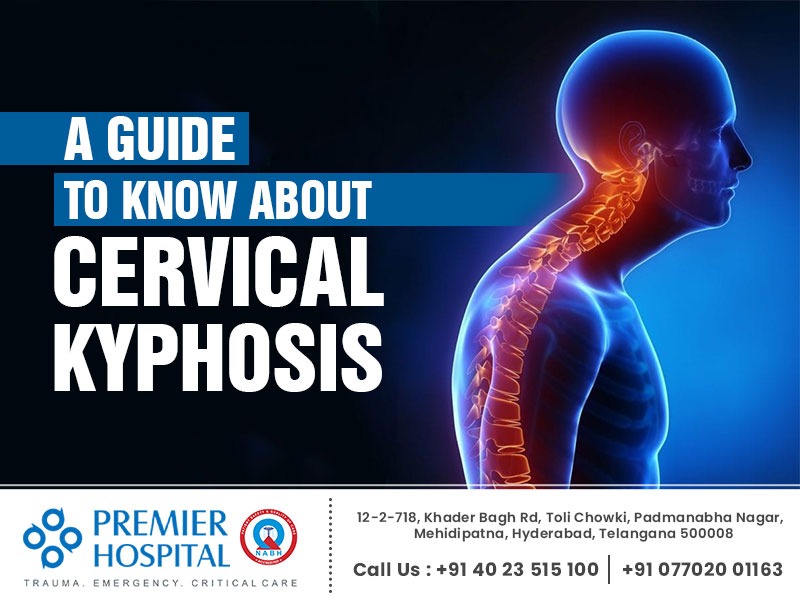A Guide To Know About Cervical Kyphosis
by Premier Hospitals | October 21, 2020 |
Many curves can be seen from the side of the spine. These curves work as a shock absorber and hold some weight from the body. Your spinal column is divided into the upper spine (neck), which is known as the cervical spine. The lower back is known as the lumbar spine, and it has inward curvature(lordosis). The thoracic spine, which is called the upper back, has an outward curve in general. However, if the spine loses its natural shape, then the condition creates problems. Similarly, if the cervical spine loses its shape and forms an abnormal "C" shaped curve, it is called cervical kyphosis. Naturally, the cervical spine has a "lordotic" curvature. The kyphosis develops a C-shaped curve facing outwards contrary to natural inward curvature. If the spinal curves grow more significant, it results in adverse health issues - the larger the curve, the more serious it will be your problem. Kyphosis is a condition of the abnormally-shaped cervical spine. Causes Of Cervical Kyphosis Both children and adults are prone to develop cervical kyphosis, and the causes are several. While sitting, working on your computer, or sleeping, poor neck posture is one of the main reasons for many cervical problems. However, some medical conditions also lead to cervical kyphosis. Degenerative Disc Disease: It is the main cause of many Cervical problems in adults. Cervical discs degenerate with age, and the disc might collapse due to the vertebrae's wear and tear. As a result, the disc becomes thin, and due to the head's weight, it tilts forward, resulting in a curve outward. It progresses over the years and ends up as kyphosis, which is called Cervical kyphosis. Congenital Defects: The defect presents at the time of birth itself, which is also called a birth defect or congenital disability. Tuberculosis: Kyphosis might also develop as a result of cervical Tuberculosis(TB). TB also leads to spinal deformity and quadriplegia(paralysis). TB to the spine almost results in a kyphotic curve. Cervical Kyphosis Due To Trauma: Trauma due to a car accident, a fall, or a sports injury can damage ligaments of the spine. The fracture might develop into cervical kyphosis. In severe cases, it may lead to spinal stenosis. Iatrogenic Disorder: If cervical kyphosis is caused due to the failure of a medical procedure, it is called an iatrogenic disorder. Mostly it is caused due to an unsuccessful cervical spinal fusion surgery. Laminectomy can help to treat the disorder by creating space between the vertebrae. Cervical Kyphosis Due To Ankylosing Spondylitis: Ankylosing spondylitis(AS) is a spinal disorder, and it can also lead to severe cervical kyphosis. In this condition, the defect occurs at the meeting point of the cervical and thoracic spine. Ankylosing spondylitis (AS) can fuse the entire spine, which sometimes forms a forward-stooped posture called kyphosis. Chin On Chest Cervical Kyphosis: Chin on chest syndrome is a kind of hyperkyphosis where the vertebrae of your neck form abnormal curves, creating a hump. In some cases, the curve extends beyond 50 degrees that can damage the entire structure of your spine. If the muscles of the neck become weak, then it becomes difficult to straighten the neck. Along with the above causes, some other rare reasons can also lead to cervical kyphosis include spinal infections and spinal tumors. Radiation therapy for cancer in children around the cervical spine might affect cervical vertebrae progress in children. Eventually, it might develop cervical kyphosis in the future. Symptoms of Cervical Kyphosis Symptoms of Cervical kyphosis vary from person to person and ranges from mild pain in the neck to a severe deformity. If the condition is left untreated, it may lead to paralysis.
- Headache which is severe
- Muscle weakness (in arms or legs)
- Pain in the lower body parts, including fingers and toes
- Problems with coordination
- Stiffness
- Decreased range of motion
- Facing difficulty to walk
- Spine deformity
- Loss of control over bladder and bowel movements



















